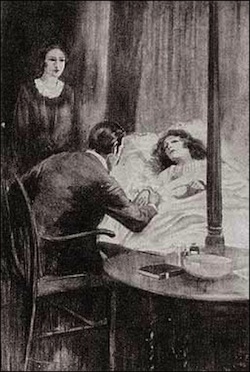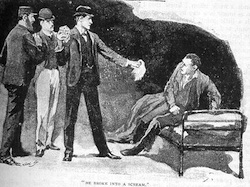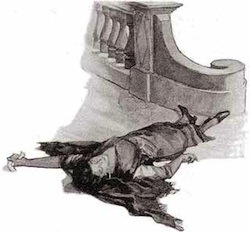In many of his adventures, the heroically smug Sherlock Holmes often acts as a debunker of pseudo-science or paranormal activity. Though arguably more high-brow, its hard to imagine the sleuths of The Mystery Machine a priori of Holmes. Paradoxically, Holmes’s creator, Arthur Conan Doyle entertained various fantastical beliefs including an interest in fairies and séances.
These sensibilities seem to forever collide within the famous Holmes maxim “when you eliminate the impossible whatever remains, however improbable, must be the truth.” (Originally from The Sign of the Four.) Holmes allows his imagination to inform his process, but only to a point. In “The Adventure of the Sussex Vampire” he says “This Agency stands flat-footed upon the ground and there it must remain. The world is big enough for us. No ghost need apply.” And though many post-Doyle authors have taken Holmes on fantasy and science fiction adventures (check out a selection I analyzed for Clarkesworld Magazine) below are a few stories from the original canon, which approach the universe of speculative fiction.
“The Creeping Man”
In all of the stories from the canon, “The Creeping Man” is probably the closest to science fiction insofar as it speculates on what would happen if an ordinary man tampered with his own biology. In an effort to win the affections of much younger woman, an aging academic has ingested an elixir derived from the glands of a monkey in order to activate more primal urges. However, this reckless science experiment goes awry and produces an almost Jekyll and Hyde scenario. Holmes draws some interesting observations on the transformation, many of which seem to predict fears about genetic engineering and mutation. In a way, the science fiction of this story also serves as the answer to the mystery. Why is Professor Presbury acting so strangely? Science fiction!
“The Sussex Vampire”
 This story is a classic example of Holmes straight-up debunking a supernatural event. Mr. Robert Ferguson is extremely concerned his wife is a blood-sucking vampire, and his evidence for thinking this is pretty damning! He’s seen his wife with blood on her lips standing over his young son, who in turn has bite marks on his neck. Yep. The woman is a total vampire. But Holmes isn’t convinced and instead of loading up on garlic and crucifixes, starts analyzing the family dynamics. Here, Holmes discovers a jealous older brother; a character who we later learn has been poisoning the young child. Mr. Ferguson’s wife is no vampire! Instead, she’s been sucking out the poison in order to save the child’s life while the real monster has been lurking closer to home. Even though everything in this story has a real-world explanation the story does make a reference to another un-seen Holmes adventure, which involved “the giant rat of Sumatra.” Holmes tells Watson that this is “a story for which the world is not yet prepared.” Here’s my guess as to what this un-chronicled tale might be about: mutant telepathic rat with laser eyes who is an expert tea-smuggler. Improbable? Perhaps.
This story is a classic example of Holmes straight-up debunking a supernatural event. Mr. Robert Ferguson is extremely concerned his wife is a blood-sucking vampire, and his evidence for thinking this is pretty damning! He’s seen his wife with blood on her lips standing over his young son, who in turn has bite marks on his neck. Yep. The woman is a total vampire. But Holmes isn’t convinced and instead of loading up on garlic and crucifixes, starts analyzing the family dynamics. Here, Holmes discovers a jealous older brother; a character who we later learn has been poisoning the young child. Mr. Ferguson’s wife is no vampire! Instead, she’s been sucking out the poison in order to save the child’s life while the real monster has been lurking closer to home. Even though everything in this story has a real-world explanation the story does make a reference to another un-seen Holmes adventure, which involved “the giant rat of Sumatra.” Holmes tells Watson that this is “a story for which the world is not yet prepared.” Here’s my guess as to what this un-chronicled tale might be about: mutant telepathic rat with laser eyes who is an expert tea-smuggler. Improbable? Perhaps.
“The Man With the Twisted Lip”
 Just how good were cosmetics of the late 19th century? Though Holmes is frequently depicted as being an excellent master of disguise, in this story he is nearly bested by someone else being in disguise. When Neville St. Clair goes missing, and well-known beggar Hugh Boone is found in his place, modern readers would probably see this identity switch-a-roo a mile away. And yet, here it’s hard to believe that this man’s wig, make-up, and everything would have remained intact upon arrest. This suspension of disbelief is actually totally necessary for the enjoyment of the story. In the end, Holmes gives Boone/St. Clair a bath, the make-up fades away and all is revealed. Of course this story plays with the notion that disguise is more than just what’s on the outside, but also how you play the part. Still, that seems to be some pretty advanced make-up for its time. Make-up of the future!
Just how good were cosmetics of the late 19th century? Though Holmes is frequently depicted as being an excellent master of disguise, in this story he is nearly bested by someone else being in disguise. When Neville St. Clair goes missing, and well-known beggar Hugh Boone is found in his place, modern readers would probably see this identity switch-a-roo a mile away. And yet, here it’s hard to believe that this man’s wig, make-up, and everything would have remained intact upon arrest. This suspension of disbelief is actually totally necessary for the enjoyment of the story. In the end, Holmes gives Boone/St. Clair a bath, the make-up fades away and all is revealed. Of course this story plays with the notion that disguise is more than just what’s on the outside, but also how you play the part. Still, that seems to be some pretty advanced make-up for its time. Make-up of the future!
“The Problem of Thor Bridge”
 While a vast portion of Holmes stories are not whodunits, the ones that DO feature a dead body and a list of suspects are great reads. “The Problem of Thor Bridge” presents a classic twist on the whodunit because the murder victim ends up being a suicide. The victim, Maria actually shot herself, but made it look like Miss Dunbar killed her. How did she pull this off? Well, it appears she had a pretty good knowledge of the way physics works in relation to revolvers. By attaching a gun to a rope, Maria calculated the trajectory of where the pistol would go after the fatal shot had gone off and pulled the weapon from her hand. The idea was to get rid of the real murder weapon by hiding in the water under the bridge. Maria’s plan works perfectly, except of course for the fact that Sherlock Holmes figures it out. While the science of all of this is theoretically possible, this does seem to be one of the more improbable scenarios in a Holmes adventure. A lot of variables could have made this plan go wrong. However, the story firmly speculates that in this case, everything went right.
While a vast portion of Holmes stories are not whodunits, the ones that DO feature a dead body and a list of suspects are great reads. “The Problem of Thor Bridge” presents a classic twist on the whodunit because the murder victim ends up being a suicide. The victim, Maria actually shot herself, but made it look like Miss Dunbar killed her. How did she pull this off? Well, it appears she had a pretty good knowledge of the way physics works in relation to revolvers. By attaching a gun to a rope, Maria calculated the trajectory of where the pistol would go after the fatal shot had gone off and pulled the weapon from her hand. The idea was to get rid of the real murder weapon by hiding in the water under the bridge. Maria’s plan works perfectly, except of course for the fact that Sherlock Holmes figures it out. While the science of all of this is theoretically possible, this does seem to be one of the more improbable scenarios in a Holmes adventure. A lot of variables could have made this plan go wrong. However, the story firmly speculates that in this case, everything went right.
“The Devil’s Foot”
This one is probably one of the more horrific stories of the canon because the imagery throughout is of the phantasmagorical type. In the Cornwall countryside, two brothers — George and Owen Tregennis — have gone completely batshit crazy, while their sister Brenda is dead. The three were all in the same room, and the explanation for this is unknown. The housekeeper and the surviving brother, Mortimer, are chalking the whole thing up to the work of the devil. Unsurprisingly, Holmes isn’t having any of that and goes to work to figure out what really went down. Eventually, the culprit is none other than chemical warfare. A plant called the Radix pedis diabolic was placed in the fire by Mortimer, and when burned, the effect of this plant are toxic, causing insanity in the two brothers and death for Brenda. Naturally, it was all about money, though Mortimer does get killed in the same way by Dr. Sterndale, a man who was in love with Brenda. Quite the bloodbath in this one!
Notably the Radix pedis diabolic does not actually exist (A New York Times article tackled this in 1990) making the entire mode of murder a total science fiction construct. On top of all of that, this story gives us extremely suspenseful scene in which Holmes tests The Devil’s Foot on himself, goes a bit crazy, and nearly dies. Luckily, Watson is there to drag him out at the last second. As Holmes stories go, the action, horror, mystery and, yes, science fiction, are nearly perfectly balanced here.
There are of course, other Doyle Holmes stories which feature exciting science fiction-style action, but I think these represent the most prominent ones. What about you fellow Holmesians? Which other stories could be considered speculative fiction? Further, what are your views on the giant rat of Sumatra? Comment below!
Ryan Britt is the staff writer for Tor.com. He was written about Sherlock Holmes for Tor.com here, here, and here. He’s also written about Holmes for Clarkesworld Magazine.









